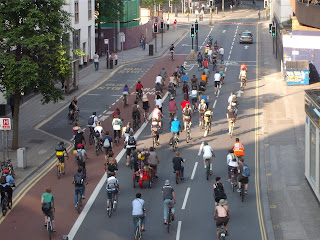 Obligatory smoking chimney pic
Obligatory smoking chimney picLet me say at the outset that I'm not the only person proposing this kind of approach and I'm not claiming it as some great leap in thinking. It is merely the simple application of free market principles (no, that's not an oxymoron) to the problem, an application of the 'polluter pays' principle and an example of an ecotax. It's simple in essence so easily understood by the consumer but would allow for the evolution of sophistication, entreprise and diversity in it's implementation (which I'll describe in Part 2). What's most important, in contrast to Cap-and-Trade, it would actually work.
The essence of the system is that the consumer of goods or services should pay for the environmental costs arising from the supply of those goods or services, including of course the cost of carbon dioxide and other greenhouse gases. In the case of carbon dioxide the cost would be what it actually costs to neutralise or fully mitigate the environmental impact. So far so familiar. But then the final element is where it gets interesting. The environmental costs paid by the consumer must be used to pay for (and will be determined by) the environmental neutralisation or mitigation so that the impact really is neutralised/mitigated.
I'll describe the mechanism for doing this in some detail in Part 2 in due course but let's first consider how such a system would work in principle. Say Mr Consumer wants to travel to exotic climes. He looks at air fares, but finds that the incorporation of the environmental costs makes air travel much more expensive. He then has three choices.
- Pay the higher air fare and fly (in which case his environmental impact will be neutralised/mitigated so no problem).
- Travel by some other means and/or a shorter distance with a lower environmental impact and pay the lower environmental costs (in which case no problem)
- Not travel (in which case no problem).
Nobody would be denied the theoretical choice of flying, or driving an inefficient car, or whatever, but since such options would become so much more expensive only the relatively wealthy will have the practical means to choose (which is already true for most of the world's population anyway). The consequence would be a big shift in consumption patterns and the demise of many contemporary business models, notably those predicated on cheap air travel like, er, the World Cup (good choice Bristol City Council). Businesses would have to adapt and quickly to survive and prosper.
So problem solved? All the world's nations have to do in Copenhagen is agree to adopt such a system in good time and we can all forget about the worst of the Global Warming scenarios (unless it's already too late, in which case we can worry about our future survival instead on how to avoid Climate Change)? But of course they won't for the very simple reason that it would actually work. That is the last thing that powerful business interests want. Better for them to carry on with failing policies like Cap-and-Trade than adopt a policy that will actually work.









 "Road Safety GB has launched a campaign to highlight the extent of the danger presented to children by the darker evenings that follow October’s clock change."
"Road Safety GB has launched a campaign to highlight the extent of the danger presented to children by the darker evenings that follow October’s clock change."



























